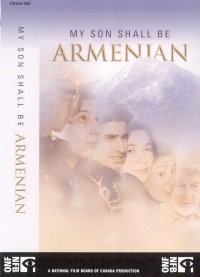| ________________
CM . . .
. Volume XII Number 13 . . . .March 3, 2006
My Son Shall Be Armenian is a documentary about six Canadians of Armenian descent who travel to present day Syria and Armenia in order to retrace the steps of their ancestors who died during the Armenian genocide of 1915. Filmmaker Hagop Goudsouzian dedicates the documentary to his father and son. Goudsouzian was born in exile in Egypt, as were his parents. The family arrived in Canada in 1961 while Hagop was still a boy. Goudsouzian's father died before Armenia became a free country in 1993 and thus was never able to set foot on Armenian soil (his mother was able to do this before she died). Goudsouzian gathers together five others like himself: Montrealers whose roots are in Armenia and who lost family during the genocide. The six speak French, but the film has English subtitles and the narration is in English This documentary does a good job of making the rich history Armenia relevant to Canadians. It's interesting to watch these six Canadians' emotional reactions as they step on Armenian soil for the first time. One of them brings along a small box that contains his grandfather's ashes. His grandfather's lifelong dream was to visit Armenia. The heart of historical Armenia is Mount Ararat, where Noah's Ark is fabled to have landed after the flood, but Mount Ararat is now in Turkish hands and has been since 1921. The travellers have the bittersweet opportunity to see Mount Ararat with their own eyes, albeit beyond the barbed wire that separates present day Armenia from Turkey. In 1915, the new Young Turk government which had overthrown the Sultan instituted a "New Turkey" policy of persecution directed against people who were not of Turkish origin. The Armenians were the largest non-Turkish ethnic group, and between 1915 and 1923, one and a half million Armenians were exterminated. This cold fact is well known and easily forgotten, but what this documentary does is bring the genocide back to life. The travellers walk in the footsteps of the deportees. The film of their journey is interspersed with archival photographs of the genocide itself. At one point, they go to Deir Ez Zor, in the heart of the Syrian desert, where thousands of Armenians perished. A church stands there now. Goudsouzian kneels down and scrapes the surface of the soil around the wall of the church and he discovers bones. To his horror, he realizes that he is standing on a mass grave. Perhaps he is standing on the bones of his own great-grandparents. Another time, he scoops up sand and intermixed with the bones is a plain brass wedding ring and a bullet. The immediacy of the genocide is palpable, even after all these years. The six Canadians then journey to what is now Armenia. It is not on the same soil as historical Armenia, and the people there have named the villages after the old ones from which that they had been deported. The Canadians search for survivors. This isn't an easy task because most of the survivors have died long ago. They do manage to find several who are in their 90s and even two who are 100 years old, and they recount what happened to their parents and siblings as if it had happened yesterday. Interspersed with the survivors' first person accounts are clips of archival photographs and also footage from a Hollywood silent movie that was made based on the accounts of one survivor who escaped to the United States during the genocide. The narrator asks, if this silent movie was being shown in North America between 1915 and 1923, why did the West not intervene? Good question. The documentary is a long one—81 minutes—and it loses steam about halfway through when the focus shifts to the political issue of nations officially recognizing the fact of the Armenian genocide. While this is an important issue, it could have been dealt with much more effectively with stringent editing of footage. This documentary is most suited to high school students and older elementary students. While the genocide is dealt with compassionately and without unnecessary graphic detail, it wouldn't capture the attention of younger students. However, teachers might preview the documentary and show selected portions to any grade level. Recommended. Marsha Skrypuch has written three novels set during the Armenian genocide: The Hunger (1999), Nobody's Child (2003), Aram's Choice (2006) and is currently writing the sequel to Nobody's Child.
To comment
on this title or this review, send mail to cm@umanitoba.ca.
Copyright © the Manitoba Library Association. Reproduction for personal
use is permitted only if this copyright notice is maintained. Any
other reproduction is prohibited without permission.
NEXT REVIEW |
TABLE OF CONTENTS FOR THIS ISSUE
- March 3, 2006.
AUTHORS |
TITLES |
MEDIA REVIEWS |
PROFILES |
BACK ISSUES |
SEARCH |
CMARCHIVE |
HOME |
